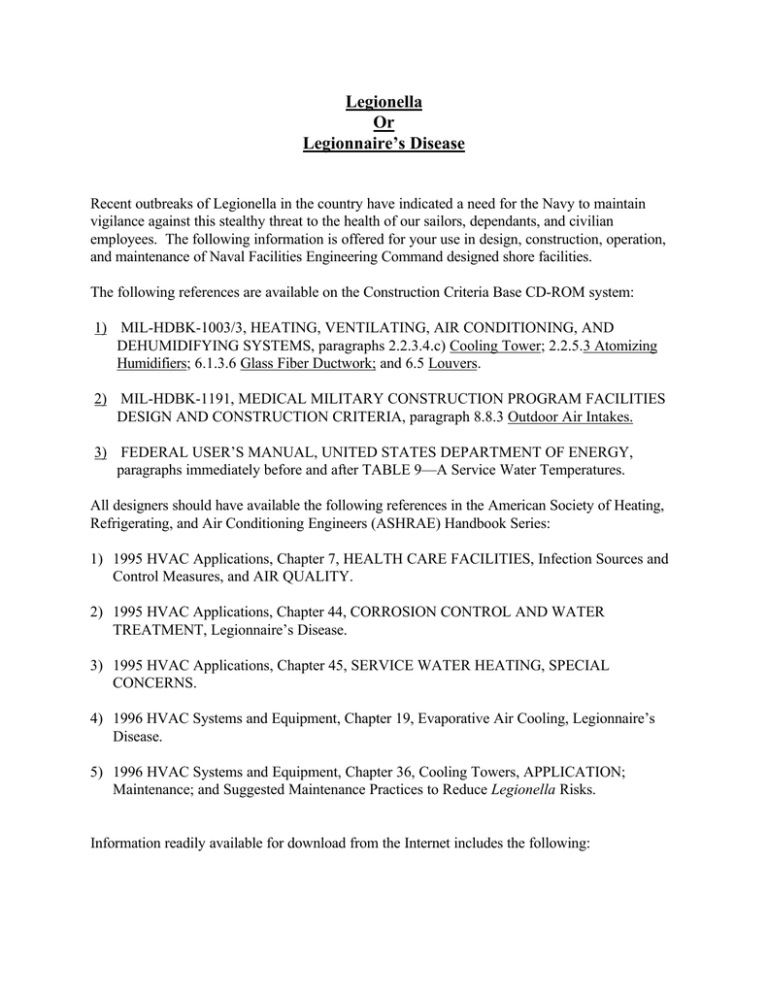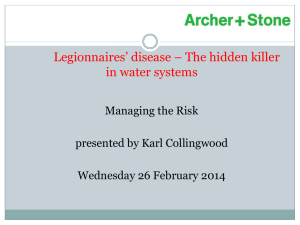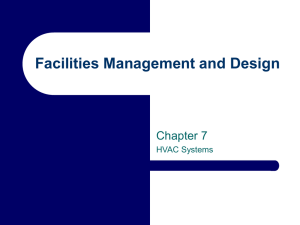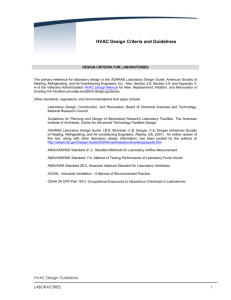Legionella Or Legionnaire’s Disease
advertisement

Legionella Or Legionnaire’s Disease Recent outbreaks of Legionella in the country have indicated a need for the Navy to maintain vigilance against this stealthy threat to the health of our sailors, dependants, and civilian employees. The following information is offered for your use in design, construction, operation, and maintenance of Naval Facilities Engineering Command designed shore facilities. The following references are available on the Construction Criteria Base CD-ROM system: 1) MIL-HDBK-1003/3, HEATING, VENTILATING, AIR CONDITIONING, AND DEHUMIDIFYING SYSTEMS, paragraphs 2.2.3.4.c) Cooling Tower; 2.2.5.3 Atomizing Humidifiers; 6.1.3.6 Glass Fiber Ductwork; and 6.5 Louvers. 2) MIL-HDBK-1191, MEDICAL MILITARY CONSTRUCTION PROGRAM FACILITIES DESIGN AND CONSTRUCTION CRITERIA, paragraph 8.8.3 Outdoor Air Intakes. 3) FEDERAL USER’S MANUAL, UNITED STATES DEPARTMENT OF ENERGY, paragraphs immediately before and after TABLE 9—A Service Water Temperatures. All designers should have available the following references in the American Society of Heating, Refrigerating, and Air Conditioning Engineers (ASHRAE) Handbook Series: 1) 1995 HVAC Applications, Chapter 7, HEALTH CARE FACILITIES, Infection Sources and Control Measures, and AIR QUALITY. 2) 1995 HVAC Applications, Chapter 44, CORROSION CONTROL AND WATER TREATMENT, Legionnaire’s Disease. 3) 1995 HVAC Applications, Chapter 45, SERVICE WATER HEATING, SPECIAL CONCERNS. 4) 1996 HVAC Systems and Equipment, Chapter 19, Evaporative Air Cooling, Legionnaire’s Disease. 5) 1996 HVAC Systems and Equipment, Chapter 36, Cooling Towers, APPLICATION; Maintenance; and Suggested Maintenance Practices to Reduce Legionella Risks. Information readily available for download from the Internet includes the following: 1) Legionellosis Position Paper, ASHRAE Position Paper, 25 June 1998, at http://204.7.184.20/ABOUT/leg_papr.htm. 2) Legionnaires’ Disease, Part I. Issues on Prevention of Nosocmial Pneumonia, 1994, at http://www.cdc.gov/ncidod/. 3) Legionellosis: Legionnaires’ disease and Pontiac fever, at http://www.cdc.gov/ncidod/. 4) Building Air Quality: A Guide for Building Owners and Facility Managers, by United States Environmental Protection Agency, at http://www.epa.gov/iaq/. A synopsis of the above follows: Conditions favorable to presence and growth of Legionella: 1) Warm water, between 77F and 108F; not hot water, greater than 140F. High humidity. 2) Scale, mineral deposits, sludge, and airborne dirt particles. 3) Algae, mold, and slime. 4) Droplets of water or mist dispersed into the air. 5) Piping system dead ends and no-flow sections, potable and HVAC water systems. Things to look out for: 1) Water droplets discharged into the air. Say from decorative recirculating fountains, whirlpools, spas, hot tubs, roof ponds, safety showers, machine shop coolant systems, ice makers, wet cooling towers, pad or spray type humidifiers, showers, dish washing spray hoses in residential occupancies, and lavatory aerator nozzles. 2) Outside Air Intakes located downstream of cooling tower exhaust plumes. 3) Aircraft and automotive wash racks using recirculated water. 4) Service water heating tanks maintained at 115 degrees F, or below. Say in preheating tanks heated by solar or recovered heat. Designers should do the following: 1) Carefully locate water spray emitting devices to avoid the downwind plume entering any open windows, doors, air intakes, loading docks, sidewalks, patios, roof gardens, or otherwise occupied spaces. Locate Outside Air Intakes away from mist plumes. 2) Promptly replace any wetted air filters in HVAC systems outside air, return air, and supply air streams. 3) Provide easy cleanout of cooling tower sumps, screens, and strainers. 4) Provide automatic blowdown and chemical addition to all cooling towers to maintain cleanliness. 5) Provide service water heaters capable of and set to heat the water to a minimum of 140 degrees F. 6) Do not use wetted pad type or water spray type humidifiers. Steam injection and heated pan types are acceptable, if the pans are kept clean. 7) Control the cooling tower fans to run for a period of time after water spray ceases to dry the cooling tower fan, fill, deck, and wind screens. This will reduce fouling potential. 8) Provide covers for cooling towers with open pan distribution. Shading the pans reduces algal growth. 9) Use coatings on the inside of fiberglass ducts to avoid bacteria growth potential. 10) Avoid piping system dead ends and no-flow sections, for potable and HVAC water systems. Operation and Maintenance personnel should do the following things: 1) Clean all cooling tower sumps, strainers, and screens monthly. Towers are efficient air washers, and much atmospheric dirt will accumulate in the sumps, and circulate throughout the condenser water system. This dirt provides food for the growth of bacteria. Deposits will shelter the growth of algae, bacteria, and slime. These will, in turn, shelter legionella from the biocides added to the cooling water. The deposits will also plug the system, reduce heat transfer, and increase corrosion. 2) Ensure all chemical feeders and blowdown systems are working properly. Ensure chemical tanks are kept filled. 3) Flush shower nozzles and lavatory aerators with water at 140 degrees F for five or more minutes, if legionella is suspected. Remove the scale and deposits that form at the spray locations. Finally, ASHRAE states that “…well-maintained towers with proper water treatment have generally not been associated with outbreaks of legionellosis…”. Military Handbook 1003/3, HEATING, VENTILATING, AIR CONDITIONING, AND DEHUMIDIFYING SYSTEMS, page 2, paragraph 1.5, Referenced Criteria lists “The principle criteria references used in this handbook in order of priority are: a) MIL-HDBK-1190 b) NAVFAC design manual and military handbooks, … c) American Society of Heating, Refrigerating and Air Conditioning Engineers, Inc. (ASHRAE) handbooks and standards. …” Page 208 lists the “NON-GOVERNMENT PUBLICATIONS:” referenced in MH 1003/3, including all four ASHRAE Handbooks. This establishes the linkage between the NAVFAC publications and the referenced ASHRAE documents listed above.






